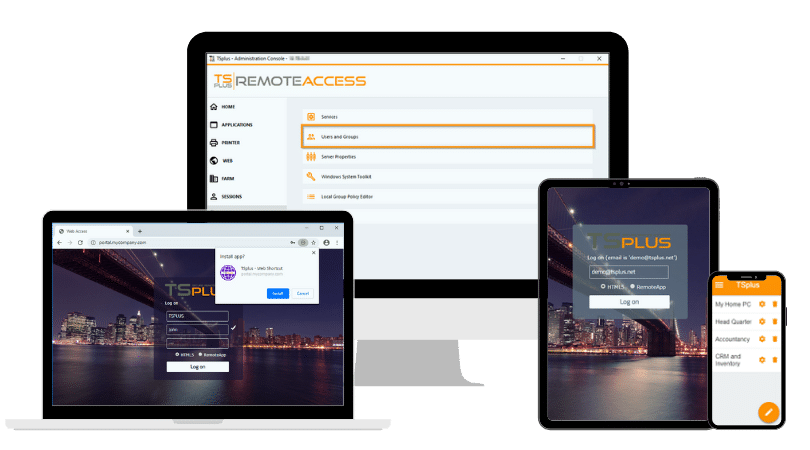)
)
Introduction
Virtualization underpins modern IT. A VM server lets one physical or cloud host run many isolated virtual machines, improving utilization, speed, and control. This guide explains what a VM server is, how hypervisors work, key benefits and trade-offs, common use cases, and best-practice design tips—plus when TSplus can simplify secure app delivery.
What is a VM Server?
A VM server (virtual machine server) is the foundational platform that executes and manages VMs. The host abstracts physical resources and schedules them across isolated guest systems. This approach enables one server to run many workloads safely and efficiently. It is a core building block for modern infrastructure where scale and speed matter.
Core definition and terminology
In Entity-first terms, the VM server (host) provides compute, memory, storage, and networking to virtual machines (guests) through a hypervisor. The hypervisor enforces isolation, handles device emulation or paravirtual drivers, and exposes management APIs. Organizations treat the host as a shared platform, while the VMs remain discrete operational units. This separation simplifies governance and improves recovery options. In practice: think “host = platform, VMs = tenants,” with clear control-plane boundaries for capacity, security, and lifecycle policy.
VM server vs Virtual Machine vs Virtual Server
A virtual machine is the guest instance running an OS and applications. A virtual server is a VM configured specifically for server roles, such as web or database services. The VM server is the physical or cloud system that runs many VMs at once. Clarity on these terms avoids design confusion and helps teams select the right delivery model for each workload.
Practically, ownership and SLAs differ: VM servers are managed by platform/infra teams, while virtual servers (the guest VMs) are owned by app or service teams with their own patching and backup policies.
Licensing and performance planning also diverge: host-level licensing and capacity (CPU, RAM, IOPS, GPUs) govern the VM server, whereas guest OS licensing, middleware sizing, and HA choices govern each virtual server’s reliability and cost.
How Does a VM Server Work?
A hypervisor abstracts hardware and schedules workloads across VMs. The platform presents virtual CPUs, memory pages, virtual NICs, and virtual disks to guests, mapping them to physical components. Storage may be local, SAN/NAS, or software-defined; networking typically uses virtual switches with VLAN/VXLAN overlays. Enterprise stacks add snapshots, live migration, HA, and policy controls to increase resilience.
Type-1 vs. Type-2 hypervisors
Type-1 (bare-metal) hypervisors, such as ESXi or Hyper-V, run directly on hardware and provide strong isolation, performance, and enterprise features. These are preferred for production and multi-tenant environments. Type-2 (hosted) hypervisors, such as VirtualBox or Workstation, run on a conventional OS. These suit labs, demos, and developer endpoints where convenience and portability are the priority.
For production, standardize on Type-1 to leverage HA, live migration, and hardware-assisted virtualization while minimizing the host-OS patch surface. Type-2 adds an extra OS layer that consumes resources and broadens the attack surface; use nested virtualization sparingly due to overhead.
Resource allocation (vCPU, RAM, storage, network, GPU)
Each VM is granted vCPU scheduling units, RAM reservations/limits, virtual disks (thin or thick), and vNICs connected to virtual switches. Policies such as reservations, shares, and limits protect critical services from noisy neighbours. Optional GPU passthrough or vGPU accelerates AI/ML, visualization, and CAD. Capacity plans should account for IOPS/latency, not just CPU and RAM.
Right-sizing also means aligning VMs to physical NUMA boundaries and tuning storage queue depths to prevent latency spikes during peaks. Consider SR-IOV/offloads and per-tenant QoS; define safe CPU/memory overcommit ratios and watch CPU ready, ballooning, and datastore latency.
What Are the Types of Virtualizations on VM Servers?
Virtualization approaches vary by isolation level and performance characteristics. Choosing the right model depends on compatibility needs, security posture, and workload profile. Many environments blend techniques to achieve the best balance between efficiency and control. Hybrid patterns are common in mid-market and enterprise deployments.
Full virtualization and paravirtualization
Full virtualization hides the hypervisor, maximizing guest OS compatibility across Windows and Linux families. Paravirtualization uses enlightened drivers and hypercalls to reduce overhead and improve I/O performance. In practice, modern stacks mix both: guests run normally while optimized drivers accelerate storage and network paths for better throughput.
Choose full virtualization when lift-and-shift compatibility across diverse OS versions is the priority. Prefer paravirtualized drivers for I/O-intensive apps to cut latency and CPU overhead at scale.
OS-level virtualization and microVMs
OS-level virtualization (containers) shares the host kernel to run isolated processes with minimal overhead. Containers are not VMs, but they are often scheduled on VMs for security boundaries and tenancy separation. MicroVMs are ultra-light VMs that boot fast and offer stronger isolation than containers alone.
They are attractive for serverless, edge, and multi-tenant scenarios. Use containers for stateless microservices and rapid CI/CD, anchored by strong runtime policies. Choose microVMs when you need near-container startup times with VM-grade isolation for multi-tenant or edge workloads.
What Are the Benefits of Using VM Servers in IT Operations?
VM servers increase utilization and reduce rack sprawl, power draw, and cooling overheads. They also accelerate provisioning through templates and automation. Operationally, VMs offer predictable recovery using images and snapshots. The result is faster time-to-value with clearer governance over who owns what and how it’s protected.
Consolidation, agility, and resilience
Consolidation places multiple workloads on a single host fleet, cutting hardware and maintenance costs. Agility comes from cloning, templating, and right-sizing VMs on demand. Resilience improves through features like live migration, HA clusters, and orchestrated failover. Together, these capabilities transform provisioning from days to minutes.
Denser hosts also lower power/cooling per workload and help you optimize core- or socket-based licensing across fewer machines. Live migration plus runbook automation lets you patch hosts with near-zero downtime and hit defined RTO/RPO targets.
Dev/Test velocity and hybrid portability
Developers and QA teams benefit from reproducible environments and safe rollback points. VMs can be versioned, snapshotted, and reset without touching production. Hybrid portability allows images to move across on-prem and cloud footprints. This flexibility simplifies seasonal scaling and disaster recovery rehearsals.
Golden images and IaC pipelines keep environments deterministic, ensuring consistent builds and patch levels. Standard image formats and drivers accelerate import/export between platforms, while ephemeral CI VMs shorten feedback loops.
What Are the Challenges and Trade-offs of Using VM Servers?
Virtualization is powerful, but it introduces new risks and operational disciplines. Without governance, VM inventories grow unchecked, and costs rise. Overcommitment can degrade performance at the worst time. Teams need strong controls on the management plane and a clear licensing strategy.
Contention, sprawl, and single-host risk
Resource contention manifests as CPU ready, memory ballooning/swapping, and storage latency. VM sprawl increases attack surface and operational cost when owners and lifecycles are unclear. A single host becomes a blast radius if HA is not configured; one failure can affect many services. Capacity planning and N+1 designs mitigate these risks.
Track CPU ready %, swap-in rates, and datastore latency (e.g., keep <5–10 ms for steady-state) and enforce quotas to curb noisy neighbours. Establish ownership tags/CMDB entries with auto-expiry and use HA with anti-affinity plus maintenance mode/live migration to reduce single-host blast radius.
Security, licensing, and operational complexity
The hypervisor is a high-value target; hardening, patching, and restricted console access are essential. Licensing across hypervisor, OS, and tools can be intricate, especially in audits. Operational complexity rises with multi-site clusters, DR runbooks, and performance tuning. Teams should favour standard images, automation, and least-privilege access to contain complexity.
Isolate the management plane (dedicated network), enforce MFA/RBAC with audited change control, and rotate credentials/keys regularly. Normalize licensing (per-core/host, OS CALs, add-ons) in a single inventory, and operationalize with IaC-runbooks, tested failover playbooks, and periodic chaos/exercise drills.
What Are The Best Practices & Design Tips for VM Servers?
The most reliable VM environments start with capacity models that include failure headroom. Network, storage, and security designs should be intentional and documented. Monitoring must align with service-level objectives rather than generic thresholds.
Capacity planning and SLO-driven monitoring
Plan for N+1 so a host can fail without breaching performance targets. Model CPU, RAM, and especially storage IOPS/latency at peak. Monitor CPU ready %, memory ballooning/swapping, datastore latency, and east–west flows. Tie alerts to SLOs to prioritize action and reduce noise.
Set hard budgets (e.g., CPU ready <5%, p95 latency <10 ms, swap-in ≈0) and forecast with rolling 30/90-day trends for growth. Use workload-aware dashboards (per-tenant, per-datastore, per-VM) and route alerts to on-call with escalation and auto-remediation runbooks.
Network segmentation, hardening, and data protection
Separate management, storage, and tenant traffic with ACLs and MFA on consoles. Harden the hypervisor, restrict APIs, and audit changes. Protect data with immutable backups, periodic restore tests, and encryption at rest and in transit. Maintain golden images, automate configuration, and enforce lifecycle tags to avoid drift.
Deploy dedicated mgmt VLAN/VXLAN, lock console access behind VPN/zero trust, and enable signed/secure boot where supported. Test restores quarterly with checksum verification, apply 3-2-1 backup strategy, and track drift via image hashing and configuration compliance reports.
How TSplus Remote Access Can Be an Alternative to VM Servers?
Not every remote delivery need requires a per-user VM or a full VDI stack. Many organizations simply want secure, browser-based access to Windows applications or full desktops. In these scenarios, TSplus Remote Access can replace VM proliferation while preserving security and user experience.
If the primary goal is to deliver Windows apps/desktops to distributed users, TSplus Remote Access publishes them through an HTML5 web portal with TLS, MFA, and IP filtering. This removes the need to stand up new VM hosts, brokers, and profiles for each user. For SMB and mid-market teams, it often cuts cost and operational overhead dramatically while maintaining policy control.
Where OS-level isolation or tenant separation is mandatory, TSplus front ends your existing VM servers. The platform provides a hardened gateway, granular app publishing, and a user-friendly portal. You keep the VM architecture for isolation but simplify access, authentication, and session management—reducing complexity versus heavyweight VDI alternatives.
Conclusion
VM servers remain essential for consolidation, agility, and structured governance. They shine when enterprises require isolation boundaries, predictable recovery, and hybrid flexibility. At the same time, many remote delivery goals can be met faster—and at lower cost—by publishing applications with TSplus Remote Access. Use VMs where isolation is required and use TSplus to streamline secure access across physical or virtual Windows hosts.

TSplus Remote Access Free Trial
Ultimate Citrix/RDS alternative for desktop/app access. Secure, cost-effective, on-premises/cloud














)
)
)